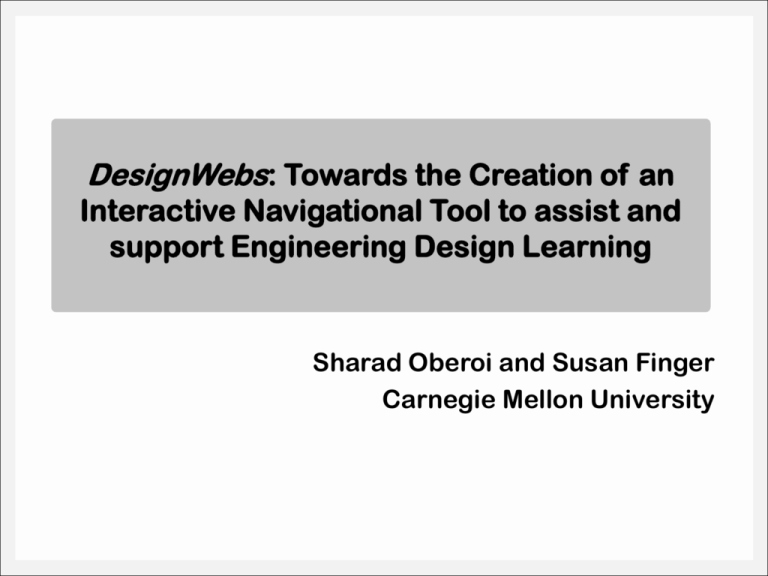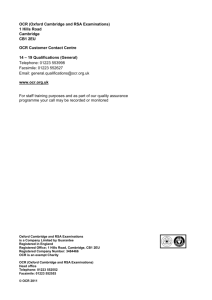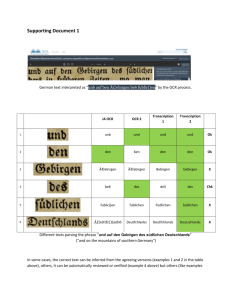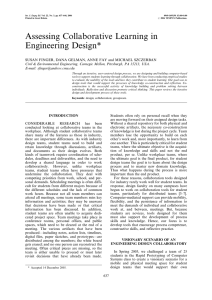slides
advertisement

DesignWebs: Towards the Creation of an Interactive Navigational Tool to assist and support Engineering Design Learning Sharad Oberoi and Susan Finger Carnegie Mellon University Collaborative learning in design • Goal – Develop tools that encourage process competence, constructive skills, and reflective practice • DesignWebs: Construct product structures underlying a design artifact from documents and discussion transcripts in real-time using machine learning approaches and language technologies Collaborative learning in design • Assertions – Most learning in design classes takes place in team meetings and in individual activities undertaken to help meet team goals – Argumentation, co-construction, and reflection are important elements of collaborative learning Outline • Setting – Engineering design capstone course – Ongoing project to understand collaborative learning by student design teams Collaborative learning in design • Observations for design teams – Knowledge generated during the design process frequently goes uncaptured, and when captured, it is usually poorly organized and buried in obscure documents – The design and development process requires that collaborators build and retain knowledge through discussions, creating documents and sharing artifacts – Effective capture of both semantic knowledge and episodic knowledge can have many benefits for both student and professional design teams Student design projects • Characteristics – Students bring together knowledge from different sources: • collaborate among themselves, • share design knowledge • negotiate with each other, faculty members and the client, in order to create engineering artifacts. – Students reuse previous knowledge and create new knowledge within the context of the problem. Engineering design projects • Common Problems – Within team knowledge sharing – Across team knowledge sharing – Global information access and integration Engineering design projects • Common problems of student projects – Requirements deviations – Difficulty in locating the right piece of information – Multiple versions of documents with contradictory information – Novices in design: Students lack the perspective to structure and manage documents they generate and use Visionary Scenario A student is working is developing a module for a mobile device that involves a text to speech application. The instructor tells her that two years ago the class in this course developed an OCR module for a cell-phone as part of the Trinetra project to assist visually impaired individuals in their daily activities, namely shopping and public transportation. She accesses the Trinetra DesignWeb through the class web space. Visionary Scenario She quickly searches (using standard search) to find the subweb for the OCR module. She then browses within the OCR module exploring various aspects of the OCR design from the previous team. Visionary Scenario Finally she focuses on the modules on the mobile device. She reads the segment of the final report on the OCR mobile module as well as some of the supporting documents that led to the final decisions in the OCR design. Visionary Scenario She imports the OCR node (with its associated document fragments, discussions and web links) from the previous year’s DesignWeb and link the node to her team’s current DesignWeb. She makes a post on the Kiva discussing what she found in the documents and propose some new directions that build on the prior work Objectives • To create DesignWebs that – represent the state of the project based on the artifacts described in the project documents – enable designers to search and navigate to find relevant information quickly and efficiently – evolve as the artifact, and the documents about it, evolve. Capturing in-process data • For 4 years, RPCS has used the Kiva for team collaboration – Light-weight collaboration tool – Combines functions of e-mail and bboards – Widely accepted and liked by student teams; it feels likes chat and meets their needs – Each year’s Kiva has hundreds of threads and thousands of posts and files We have 4 years of data of all the team conversations and files that would normally go through email or chat Kiva collaboration tool • Takes advantage of students willingness to send email, use IM, post on newsgroups, send text messages • Design goal: Create an interface that students perceive to be equivalent to their preferred communication modes; that is: make it feel like chat Design education testbed • RPCS: Rapid prototyping of computer systems – Interdisciplinary, capstone design course – Ambitious projects, e.g. • GM companion car-driver interface • Context aware cell-phone • Wireless classroom on the Voyager science boat Challenges • Levels of abstraction • Alternate views for different users • Credibility of source (transcripts of meetings vs. final reports) • Identifying the structure of created knowledge, especially for different versions of the same document • Identifying the design intent Strategy Overview • Divide documents into topic segments • Summarize each segment • Cluster segments by semantic similarity (e.g. revisions of same paragraph or similar paragraphs from different sources) • Perform co-word analysis to construct multiple networks that map the strength of association between keywords in textual data • Develop graphical display algorithms that enable users to search and navigate the graphs to access the underlying documents Conclusions • Creating DesignWebs automatically from student design documents is useful for organizing the information into product structures. • These product structures can be used for developing computational environments that support systematic modeling and also for characterizing design problems. • DesignWebs can help us understand the content and nature of information related to various aspects of the artifact and how designers generate and refine it. Future Work • Future research will incorporate the audio transcripts of student discussions during team meetings since our observation shows that interesting discussions often happen there. • We are currently focusing only on student design projects; however, this research is significant for professional designers working on industrial projects as well. Questions?





